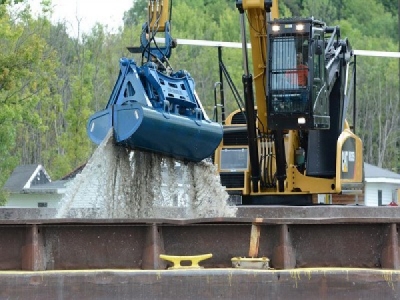
Posted on January 2, 2017
By Stephen Williams, The Daily Gazette
The federally supervised cleanup of PCB contamination on the Hudson River has failed to protect public health or the environment, the state Department of Environmental Conservation said in a new report on the six-year dredging project.
The report released Tuesday and a statement from DEC Commissioner Basil Seggos are the latest developments in an intensifying effort to get the U.S. Environmental Protection Agency to acknowledge shortcomings in the work, in which General Electric has spent more than $1 billion to remove 2.65 million cubic yards of polychlorinated biphenyl-contaminated sediment from a 40-mile stretch of the upper river.
“It’s simple. DEC is calling on the EPA to finish the job and hold GE accountable for cleaning up the Hudson River,” Seggos said. “If EPA won’t do the job and protect New Yorkers and the environment, DEC is ready to step in and lead.”
The EPA said it would take the comments under consideration as it reviews whether the dredging has been effective, while GE said the project has been a success.
In its new study, DEC said the dredging that began in 2009 and concluded in 2015 left significant amounts of PCBs in the river, and that its study found that PCB levels in fish samples haven’t dropped as anticipated. It also urged that EPA expand its current follow-up testing to include the lower part of the river, between the Troy dam and New York Harbor, where there may be PCBs but their concentrations are smaller.
Just a month ago, DEC officials told the EPA that more than 1,800 test samples need to be taken to determine PCB concentrations, and they said DEC may take the samples itself next spring and send the bill to GE. In a written response last week, EPA Regional Administrator Judith Enck said the EPA believes it is taking enough samples — about 375 — to come up with statistically valid conclusions about whether the cleanup has worked, and one of DEC’s goals — looking for new places that need to be dredged — is beyond the scope of the study.
The DEC report was released as the EPA conducts a legally mandated five-year review of whether the dredging has been effective in addressing the river as a federal Superfund site. The EPA is currently taking public comment, in anticipation of issuing a conclusion in April.
This is the first five-year review since the end of dredging, and Hudson River environmental groups have been unanimous in calling for the EPA to order GE to do additional cleanup work.
“DEC’s report confirms what Riverkeeper has been arguing for years: There’s much more contamination in the river than anticipated, the fish consumption advisories are not working, and the decades-long delay for recovery of the river is unacceptable,” said Abigail Jones, a staff attorney for Riverkeeper, which is based in Ossining.
EPA officials have said GE has lived up to the terms of the cleanup order issued in 2002, and that it’s too soon to see a drop in the PCB levels in fish taken from the river.
In response, GE issued a statement saying DEC has previously agreed with the scope of the cleanup work, and what’s been done has been successful.
“The project was a major environmental success,” GE spokesman Mark Behan said. “PCB levels in water were expected to decline after dredging and they have, as much as 60 percent in the Upper Hudson compared with pre-dredging levels. Further declines are anticipated.”
The company said fish samples are still being influenced by the disturbances caused during dredging, and contamination levels will drop over time. An EPA official, speaking at a recent community meeting, said it will be 2017 before researchers will be catching and sampling fish that weren’t exposed to PCBs during the dredging.
“GE commends and supports EPA’s careful, science-based approach for evaluating the Hudson River cleanup,” Behan said.
“The EPA will take DEC’s recommendations into consideration as part of the agency’s ongoing five-year review for the site,” EPA spokesman Elias Rodriguez said in response to DEC. “EPA will consider the comments as part of the public record, along with other comments received.”
The PCBs, a suspected carcinogen, were discharged between 1947 and 1977 from GE capacitor plants in Hudson Falls and Fort Edward.
Source: The Daily Gazette





